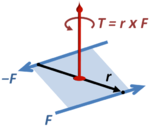Moment of a force

The torque vector T representing the equal and opposite co-planar forces F separated by a displacement vector r, constituting a force couple.
The moment of a force, sometimes called torque by engineers, quantifies the ability of a force to generate rotational motion about an axis. The moment of a force can be calculated by multiplying the length of the line between the axis of rotation and the point of application of the force by the component of the force which is perpendicular to that line. In vector notation this is written, using the vector product, as:
where M is the moment of the force, r is the displacement vector from the axis of rotation to the point of application of the force and F is the force vector.
Since the moment of a force consists of the product between a distance and a force the SI units for moments are newton meter (Nm). These are dimensionally the same as the units for work done, joule (J), which is also formed from the multiplication of a force with a distance. However, being two distinct and separate physical concepts the units are always written as newton meter and never as joule.
As a vector quantity the moment of a force has a direction as well as a magnitude. In most two-dimensional problems this is simply reduced to thinking of it as either a clockwise or anticlockwise moment. However, in three dimensions the moment vector is parallel to the axis of rotation. Empirically the direction of the vector is given by the right-hand rule: curl your fingers of your right hand about the axis of rotation in the direction of the force and your thumb will give the direction of the moment vector.
Equivalence of a force to a displaced force and couple
A force F applied to a rigid body at a distance d from the center of mass has the same effect as the same force applied directly to the center of mass and a couple Cℓ = Fd. The distance ℓ is called the arm of the couple, C is the force of the couple, and the product Cℓ is the moment of the couple. The couple produces an angular acceleration of the rigid body at right angles to the plane of the couple, but zero linear acceleration.[1] The force at the center of mass accelerates the body in the direction of the force without change in orientation.
The equivalence applies to a force applied at any point and the same force applied at any other point. The general theorems are:[1]
- A single force acting at any point O′ of a rigid body can be replaced by an equal and parallel force F acting at any given point O and a couple with forces parallel to F whose moment is M = Fd, d being the separation of O and O′. Conversely, a couple and a force in the plane of the couple can be replaced by a single force, appropriately located.
- Any couple can be replaced by another in the same plane of the same direction and moment, having any desired force or any desired arm.[1]
Notes
- ↑ 1.0 1.1 1.2 Augustus Jay Du Bois (1902). The mechanics of engineering, Volume 1. Wiley, p. 186.

